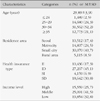Abstract
Purpose
To examine delivery type of mother who have had a previous cesarean and identify maternal factors related to type of delivery.
Methods
The study sample included 60,504 mothers who had delivered through cesarean section. Related variables were categorized as sociodemographic factors (age, residence, health insurance type, income level) and clinical characteristics (14 maternal factor, 4 fetal factor and pre-term). For data analysis, χ2 and multivariate logistic regression were conducted.
Results
Among the 60,504mothers, 3,075 were delivered through Vaginal Birth After C-Section (VBAC) and the VBAC rate was 5.1%. Underage 34, the VBAC rate increased according to age increases up to 3%. Mothers residing in urban areas had VBAC more frequently than mothers in rural area. Mothers in the high and middle income levels had a greater possibility of having VBAC than mothers in lower income levels. A greater likelihood of increase in repeated cesarean section were found in mothers with maternal and fetal factors.
Figures and Tables
References
1. American Congress of Obstetricians and Gynecologists. Clinical management guidelines for obstetricia-gynecologists. International Journal of Gynaecology & Obstetrics. 1999. 66(2):197–204.
2. Ob-Gyn issue less restrictive VBAC guidelines. American Congress of Obstetricians and Gynecologists. 2010. Retrieved May 25, 2011. from http://www.acog.org/from_home/publications/press_releases/nr07-21-10-1.
3. Vaginal birth after cesarean delivery: ACOG education pamphlet AP070. American Congress of Obstetricians and Gynecologists. 2010. Retrived May 25, 2011. from http://www.acog.org/publications/patient_education/bp070.cfm.
4. Cameron C.A., Roberts C.L., Peat B. Predictors of labor and vaginal birth after cesarean section. International Journal of Gynaecology and Obstetrics. 2004. 85(3):267–269.
5. Catling-Paull C., Johnston R., Ryan C., Foureur M.J., Homer C.S. Non-clinical interventions that increase the uptake and success of vaginal birth after caesarean section: A systematic review. Journal of Advanced Nursing. 2011. 67(8):1662–1676.
6. Fawcett J., Tulman L., Spedden J. Responses to vaginal birth after cesarean section. Journal of Obstetric, Gynecologic, and Neonatal Nursing: JOGNN/NAACOG. 1994. 23(3):253–259.
7. Fraser W., Maunsell E., Hodnett E., Moutquin J.M. Randomized controlled trial of a prenatal vaginal birth after cesarean section education and support program: Childbirth Alternatives Post-Cesarean Study Group. American Journal of Obstetrics and Gynecology. 1997. 176(2):419–425.
8. Grobman W.A., Lai Y., Landon M.B., Spong C.Y., Leveno K.J., Rouse D.J., et al. Does information available at admission for delivery improve prediction of vaginal birth after cesarean? American Journal of Perinatology. 2009. 26(10):693–701.
9. Guise J.M., Eden K., Emeis C., Denman M.A., Marshall N., Fu R. Vaginal birth after cesarean: new insights. Evidence report/Technology assessment (Number 191). 2010. Minneapolis, Minnesota: Agency for Healthcare Research and Quality.
10. Health Insurance Review and Assessment Service. 2010 Report about appropriateness of cesarean: Preliminary test payment for performance. 2010. Seoul: Author.
11. Ji I.W. Vaginal birth after cesarean. Korean Journal of Obstetrics and Gynecology. 2008. 51(3):269–274.
12. Khang Y.H., Yun S.C., Jo M.W., Lee M.S., Lee S.I. Public release of institutional cesarean section rates in South Korea: Which women were aware of the information? Health Policy. 2008. 86(1):10–16.
13. Kim S.K., Cho A.J., Doh S.R., Lee K.W. 2006 Survey on the national fertility, family health and welfare in Korea. 2006. Seoul: Korea Institute for Health and Social Affair.
14. Kim T.Y., Kwon H.K., Kim I.K., Yeon H.J., Han S.W. Decision making about mode of delivery among pregrant women with previous cesarean delivery. Korean Journal of Obstetrics and Gynecology. 2003. 46(5):896–901.
15. Kim Y.M., Kim E.Y. Maternal and hospital factors impacting the utilization of rooming-in care in South Korea: Secondary Analysis of National Health Data. 2011. Manuscript Submitted for Publication.
16. Lee K.S., Lee S.I., Seo K., Do Y.M. Impact of risk adjustment with insurance claims data on cesarean delivery rates of healthcare organizations in Korea. Journal of Preventive Medicine and Public Health. 2005. 38(2):132–140.
17. Lee S.I., Khang Y.H., Lee M.S. Women's attitudes toward mode of delivery in South Korea: A society with high cesarean section rates. Birth. 2004. 31(2):108–116.
18. Martin J.A., Hamilton B.E., Sutton P.D., Ventura S.J., Menacker F., Kirmeyer S. Births: Final data for 2004. National vital statistics reports: from the Centers for Disease Control and Prevention, National Center for Health Statistics, National Vital Statistics System. 2006. 55(1):1–101.
19. Ministry for Health and Welfare & Management Center for Health Promotion. Guidelines for health promotion program. 2007. Seoul: Author.
20. Ministry for Health and Welfare. Health insurance service fee schedule. 2007. Seoul: Korean Hospital Association.
21. Park S.J., Choi K.S. Korean nurses knowledge concerning vaginal birth after cesarean (VBAC) and educational material. Journal of Korean Academic Society of Nursing Education. 1999. 5(2):267–284.
22. Rho J.H., Kim S.Y., Oh H.M., Ahn O.J., Lee S.P., Lee G.H., et al. Effect of weight gain during the pregnancy on success of vaginal birth after cesarean delivery (VBAC). Korean Journal of Perinatology. 2008. 19(3):256–261.
23. Ridley R.T., Davis P.A., Bright J.H., Sinclair D. What influences a woman to choose vaginal birth after cesarean? Journal of Obstetric, Gynecologic, and Neonatal Nursing. 2002. 31(6):665–672.
24. Selo-Ojeme D., Abulhassan N., Mandal R., Tirlapur S., Selo-Ojeme U. Preferred and actual delivery mode after a cesarean in London, UK. International Journal of Gynaecology and Obstetrics. 2008. 102(2):156–159.
25. SOGC Practice guidelines. Society of Obstetricians and Gynecologists of Canada. 2005. Retrieved September 20, 2011. from http://www.sogc.org/guidelines/public/155E-CPG-February2005.pdf.
26. Campaign for normal birth. The Royal College of Midwives. 2011. Retrieved September 20, 2011. from http://www.rcmnormalbirth.org.uk/.
27. Wagner C.L., Metts A.K. Rates of successful vaginal delivery after cesarean for patients with private versus public insurance. Journal of Perinatology. 1999. 19(1):14–18.




 PDF
PDF ePub
ePub Citation
Citation Print
Print






 XML Download
XML Download